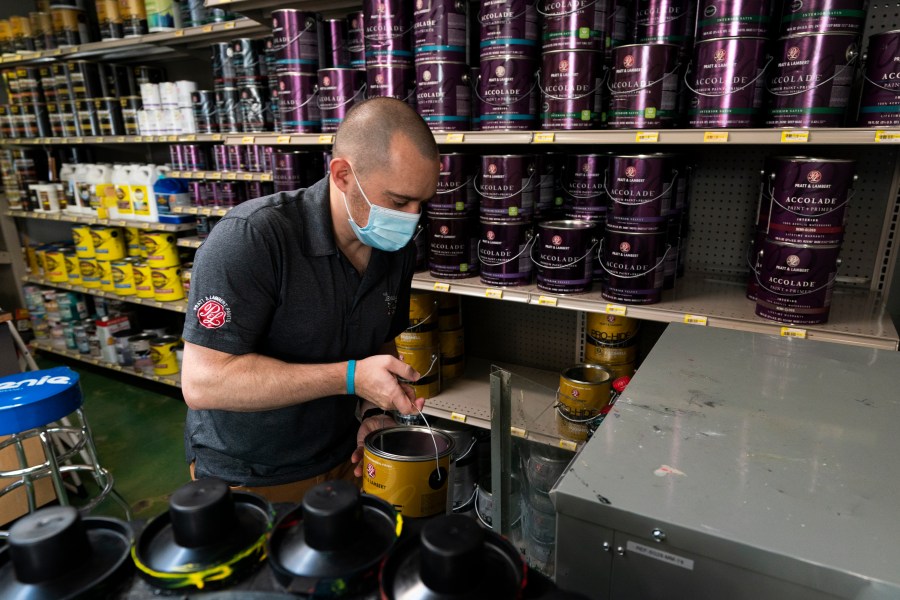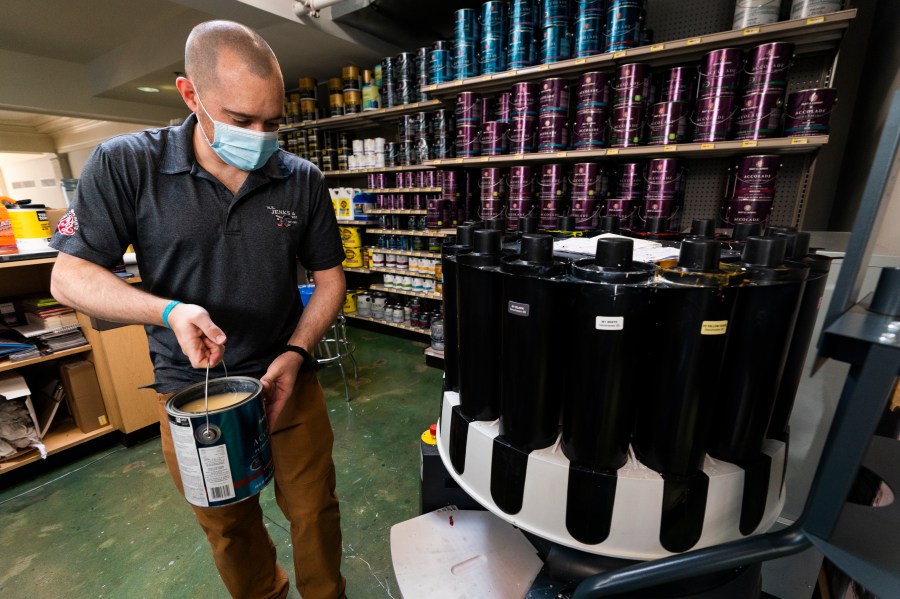The latest supply chain disruption: What the chemical shortage could mean for your wallet

Billy Wommack, purchasing director at the W.S. Jenks & Sons hardware, opens a gallon of paint at the mixing station of the hardware store’s paint department, Friday, Sept. 24, 2021, in northeast Washington. The chemical shortages, and a near doubling of oil prices in the past year, mean higher prices for many goods. (AP Photo/Manuel Balce Ceneta)
(AP) — In an economy upended by the coronavirus, shortages and price spikes have hit everything from lumber to computer chips. Not even toilet paper escaped.
Now, they’re cutting into one of the humblest yet most vital links in the global manufacturing supply chain: The plastic pellets that go into a vast universe of products ranging from cereal bags to medical devices, automotive interiors to bicycle helmets.
Like other manufacturers, petrochemical companies have been shaken by the pandemic and by how consumers and businesses responded to it. Yet petrochemicals, which are made from oil, have also run into problems all their own, one after another: A freak winter freeze in Texas. A lightning strike in Louisiana. Hurricanes along the Gulf Coast.
All have conspired to disrupt production and raise prices.
“There isn’t one thing wrong,” said Jeremy Pafford, managing editor for the Americas at Independent Commodity Intelligence Services (ICIS), which analyzes energy and chemical markets. “It’s kind of whack-a-mole — something goes wrong, it gets sorted out, then something else happens. And it’s been that way since the pandemic began.’’
The price of polyvinyl chloride or PVC, used for pipes, medical devices, credit cards, vinyl records and more, has rocketed 70%. The price of epoxy resins, used for coatings, adhesives and paints, has soared 170%. Ethylene — arguably the world’s most important chemical, used in everything from food packaging to antifreeze to polyester — has surged 43%, according to ICIS figures.
The root of the problem has become a familiar one in the 18 months since the pandemic ignited a brief but brutal recession: As the economy sank into near-paralysis, petrochemical producers, like manufacturers of all types, slashed production. So they were caught flat-footed when the unexpected happened: The economy swiftly bounced back, and consumers, flush with cash from government relief aid and stockpiles of savings, resumed spending with astonishing speed and vigor.

Suddenly, companies were scrambling to acquire raw materials and parts to meet surging orders. Panic buying worsened the shortages as companies rushed to stock up while they could.
“It’s such a bizarre scenario,” said Hassan Ahmed, a chemicals analyst with Alembic Global Advisors, a research firm. “Inventories are lean, and supply is low. Demand will exceed supply growth.”
Against the backdrop of tight supplies and surging demand came a series of events that struck Pafford as Murphy’s Law in action: Anything that could go wrong did. In 2020, Hurricanes Laura and Zeta pounded Louisiana, a hub of petrochemical production.
Then, in February, a winter storm hit Texas, with its many oil refining and chemical manufacturing facilities. Millions of households and businesses, including the chemical plants, lost power and heat. Pipes froze. More than 100 people died.
A July lightning strike temporarily shut down a plant in Lake Charles, Louisiana, that makes polypropylene, used in consumer packaging and auto manufacturing.
The industry was just beginning to recover when Hurricane Ida struck the Gulf Coast in August, once again damaging refineries and chemical plants. As if that weren’t enough, Tropical Storm Nicholas caused flooding.
“Some of these downstream petrochemical plants in the Gulf Coast regions are still shut down from Hurricane Ida,” said Bridgette Budhlall a professor of plastics engineering at the University of Massachusetts-Lowell.

“Anything related to base chemicals — they’ve had a hell of a year,” said Tom Derry, CEO of the Institute for Supply Management, an association of purchasing managers.
“It’s been the hardest year for logistics and supply chain managers,’’ Pafford said. “They always say the most stressful job in the world is being an air traffic controller at any airport … I’d venture to say that being a supply chain manager is that — or worse — this year.’’
Ford Motor Co., hampered by an industrywide shortage of computer chips, is now running short of other parts, too, some of them based on petrochemicals.
“I think we should expect, as business leaders, to continue to have supply chain challenges for the foreseeable future,” CEO Jim Farley said in an interview with The Associated Press.
The shortages are slowing production at two leading paint makers, Sherwin-Williams and PPG. Both have raised prices and downgraded their sales guidance, saying the outlook for additional supply remains dim.
Though Sherwin-Williams reported strong second-quarter profits, it said that a lack of raw materials cut sales by 3.5% for the period. CEO John Morikis said Sherwin-Williams raised prices in the Americas by 7% in August and an additional 4% this month. More increases are possible next year, he said.
The chemical shortages, combined with a near-doubling of oil prices in the past year to $75 a barrel of U.S. benchmark crude, mean higher prices for many goods.
“The consumer is going to have to pay,” said Bill Selesky, a chemicals analyst for Argus Research, who suggested that many households, armed with cash from government aid and built-up savings, will be willing to pay higher prices.

In the meantime, the supply problem isn’t getting any better. A W.S. Jenks & Son hardware store in Washington, D.C., is receiving only 20% to 30% of the paint it needs to meet customer demand without backordering. In normal times, that rate usually runs 90%, says Billy Wommack, the purchasing director.
“Nobody’s happy about it,” Wommack said. “There are a lot of ‘I’m sorrys’ out there.”
The shortage is generally felt most by big contractors that need, say, the same-colored paint for numerous apartment complexes and other major projects. Individual homeowners can typically be more flexible.
Duval Paint & Decorating, with three stores in the Jacksonville, Florida, area, is scrambling to fill orders, especially for big contractors who need a lot of paint, said John Cornell, a sales clerk who orders paint for the stores.
“We’re struggling,” Cornell said. “Sometimes you have to grab products and sit on them for weeks or months so that when the job starts we have it.”
Andrew Moore, a clerk at Ricciardi Brothers in Philadelphia, said the store has been running short of lower-grade paints that large contractors use, though here’s ample supply of higher grades. Demand is so high that the store is having a record year, with sales up 20% over last year. Prices are up as high as 15% for some brands, Moore said.
The problems in the petrochemical supply chain have been compounded by shortages of labor and shipping containers and by overwhelmed ports. Some Asian ports have been shut down by COVID-19 outbreaks. In the United States, ports like the one in Long Beach, California, are struggling with backlogs of ships waiting to be unloaded.
“I think this is going to go on for a really long time because there are so many factors at play here,” said Kaitlin Wowak, a management professor at the University of Notre Dame. “And it’s across the board in so many products.”
It’s also forcing manufacturers to rethink some of their practices. For decades, companies moved production to China to capitalize on lower labor costs. They also held down expenses by keeping inventories to a minimum. Using a “just-in-time’’ strategy, they bought materials only as needed to fill orders. But as the recession and recovery showed, keeping inventories threadbare carries risk.
“Supply chains have changed forever,” said Bindiya Vakil, CEO of the supply chain consultancy Resilinc.
The old management philosophy, she said, was to “get everything to the lowest possible price point… What we are dealing with right now is a consequence of those decisions. Companies have lost hundreds of millions, in some cases billions, of dollars in (forgone) profits because of that, because their supply chains failed.’’
The petrochemical experience, Vakil said, will teach companies to monitor the lowliest links in their supply chains. It’s always easier, she said, to track only the big-ticket items — engines, say, or electronics.
But simple plastics are vital, too. Imagine trying to market breakfast cereal without a cheap plastic bag to hold corn flakes or wheat bran.
“You can’t just dump the cereal into the cardboard and ship it,’’ Vakil says. “The plastic bag is just as critical an ingredient as the actual (product) and the cardboard and everything else. But supply chain practitioners traditionally have not considered it to be just as critical. And nowadays plastics are ubiquitous.”
Analysts expect the petrochemical crunch to last well into 2022.
“You really have to put COVID truly in the rearview mirror for this logistics situation to normalize,’’ Pafford said. “You can’t simply just throw more ships and more containers on the water. …We’ve got to get them loaded. If ports are going to be shut down because of a COVID lockdown — good luck.’’
Wiseman reported from Washington, Krisher from Detroit.










